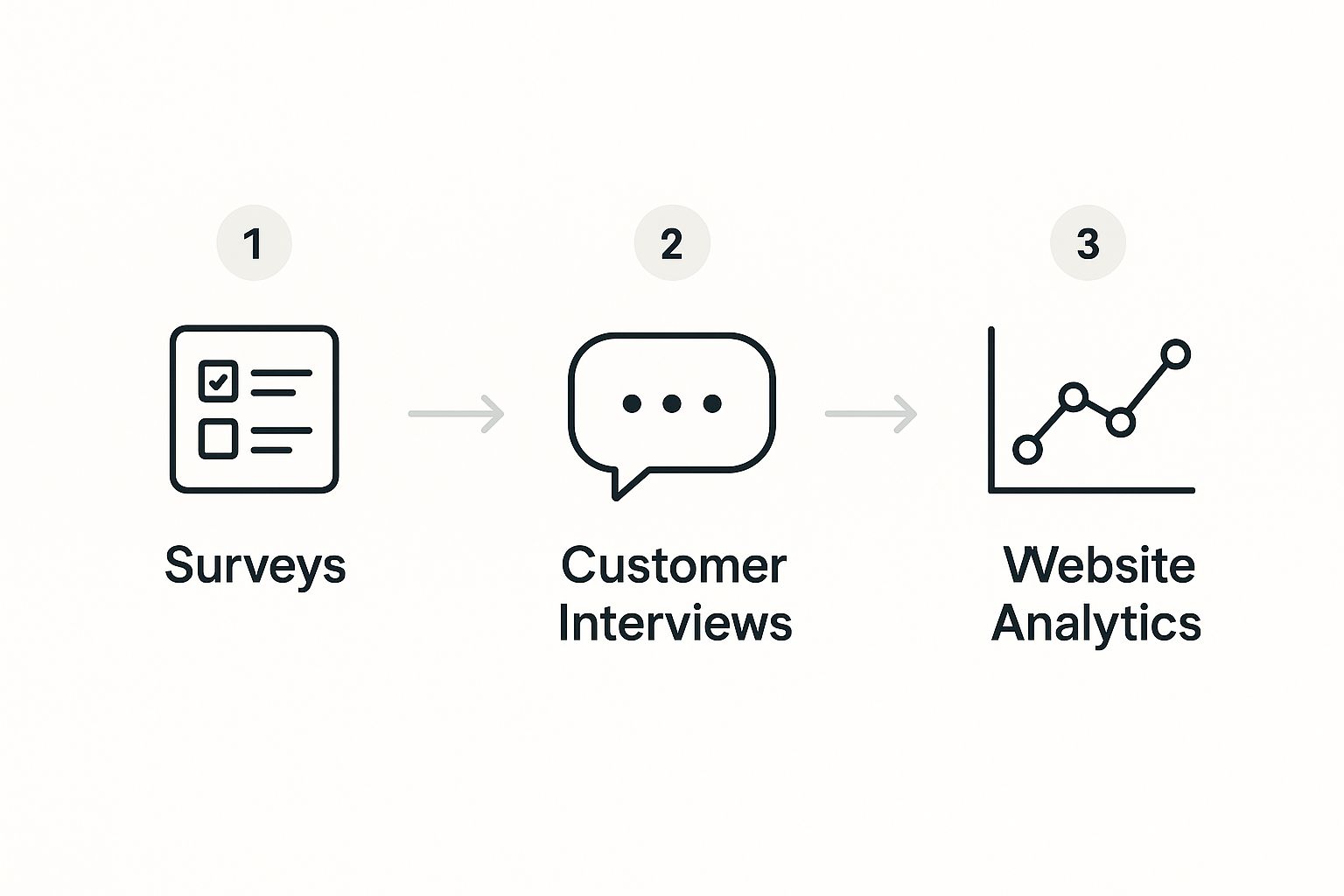Building buyer personas isn't some mystical marketing art. It’s a straightforward process: you gather real data about your customers, look for patterns in their goals and challenges, and then build a profile that represents a key slice of your audience. This is how you shift your marketing from guesswork to precision.
Why Generic Marketing Is a Dead End
In a world overflowing with marketing messages, trying to speak to everyone means you end up connecting with no one. The old playbook of casting a wide net with a generic message? It’s officially retired.
Today’s buyers expect you to get them. A vague audience description like "small business owners" is about as sharp as a butter knife—it’s not going to cut through the noise. This is exactly why figuring out how to create solid buyer personas gives you a serious strategic edge.
A buyer persona is a detailed, semi-fictional profile of your ideal customer, built on a foundation of real data and genuine insights. Think of it less like a list of demographics and more like a story that brings your customer to life.
It's Time to Move Beyond Assumptions
The biggest problem with generic marketing is that it’s built on a shaky foundation of assumptions. We think we know what our customers want, what keeps them up at night, and what really motivates them to buy. But without hard evidence, these are just educated guesses.
And those guesses lead to some painful outcomes:
- Wasted Marketing Spend: Pouring money into ads on platforms your audience ignores or creating content that just doesn't land.
- Low Conversion Rates: Your messaging falls flat because it doesn’t speak directly to specific pain points.
- Poor Product-Market Fit: You end up building features for problems your customers don’t actually have.
A well-researched persona acts as your true north. It ensures every single decision—from product development to your content strategy—is locked in on the actual needs of the people you're trying to serve.
The Bedrock of a Data-Driven Strategy
Creating buyer personas that actually work is all about the data. The whole point is to gather, analyze, and apply customer insights from every source you can get your hands on to build a profile that’s both detailed and accurate.
Marketing pros will tell you the first step is always collecting data from a mix of inputs—think market research, customer surveys, one-on-one interviews, and even diving into your Google Analytics. If you want to dig deeper, you can learn more about data-driven persona creation and see why it’s so powerful for modern marketing teams.
A buyer persona forces you to think about your customers as real people. When you can actually picture “Sarah the SaaS Manager” and her daily struggles, you’re far more likely to build a solution she’ll happily pay for.
At the end of the day, this isn't about creating some document that gets buried in a Google Drive folder. It’s about cultivating a deep, authentic sense of customer empathy across your entire organization.
When your sales, marketing, and product teams all share the same crystal-clear picture of who they’re serving, their efforts finally sync up and become infinitely more powerful. That shared understanding is the real secret to building lasting customer relationships and driving growth that actually sticks.
Finding the Data That Builds Great Personas

Truly powerful personas are built on a foundation of real data, not guesswork. This is the part where you stop assuming who your customer is and start digging into who they actually are. Honestly, this research phase is the most critical piece of the puzzle if you want to create personas that drive real-world results.
Before you can dive into data sources, you have to get crystal clear on who you're targeting in the first place. Brushing up on how to find your target audience is a great starting point to lay that groundwork. Once that’s solid, you’re ready to start mining for the details that will bring your personas to life.
Start with Quantitative Data You Already Have
Your own systems are an absolute goldmine of quantitative information. This is the hard data that provides the initial sketch of your audience, showing you behavioral and demographic trends at scale. It’s the perfect place to begin because it’s objective, and you don’t have to go far to find it.
Look for patterns inside the tools you use every day:
- Customer Relationship Management (CRM): Your CRM is packed with valuable details. Start analyzing things like job titles, company sizes, industry verticals, and geographic locations to find the common threads that tie your best customers together.
- Web Analytics: Tools like Google Analytics give you a window into how people find your website and what they do once they get there. The screenshot above shows a basic audience overview, revealing user demographics and locations at a glance. You can see which channels are driving the most traffic or which content pages hold their attention the longest. This gives you solid evidence of their interests and online habits.
Sorting customers into groups based on their purchase history or engagement levels can quickly reveal shared pain points and preferences. This foundational data helps you create meaningful segments right out of the gate.
Get Qualitative Insights from Human Conversations
While numbers tell you what is happening, talking to people tells you why. This is where your personas really start to feel human. To get that depth, you have to have actual conversations to understand their motivations, frustrations, and goals—straight from the source.
Don’t guess what keeps them up at night. Just ask.
The most powerful insights don't come from a dashboard. They come from a simple, direct question: "Can you walk me through what a typical day looks like for you?" This single question can reveal more about their challenges and priorities than any analytics report.
You can organize your qualitative research by tapping into a few key groups.
Tap into Your Internal Experts First
Your sales and customer support teams are on the front lines, every single day. They have a massive wealth of knowledge about common objections, frequently asked questions, and those "aha!" moments that ultimately lead to a sale.
Schedule some quick chats with them and ask a few targeted questions:
- What are the top reasons prospects give for not buying?
- Which features or benefits get customers the most excited?
- Describe the customers who are easiest to work with. What makes them a great fit?
- What are the most frequent support tickets or complaints you see?
This internal feedback is incredibly valuable for building a foundational understanding before you even speak to a single customer. It can also sharpen your messaging, which is especially helpful when you’re figuring out how to automate your lead generation and need your outreach to be as tailored as possible.
Conduct Direct Customer and Prospect Interviews
There is simply no substitute for speaking directly with your audience. For a truly well-rounded view, you'll want to interview a mix of people.
Your interview pool should include:
- Your Best Customers: These are your champions. You want to figure out what makes them so successful with your product so you can go find more people just like them. Ask what their world was like before your solution and how things have changed since.
- Recent Customers: Their buying journey is still fresh in their minds. Ask them about their evaluation process, what other options they looked at, and what ultimately sealed the deal for you.
- Prospects and Lost Deals: This one can feel a bit uncomfortable, but it’s often the most revealing. Talk to people who fit your ideal profile but ended up choosing a competitor or decided not to buy at all. This is where you’ll uncover major insights about gaps in your messaging or weaknesses in your product.
During these interviews, lean on open-ended questions that encourage storytelling. Instead of asking, "Is our price too high?" try something like, "Can you walk me through how you thought about the budget for this kind of solution?" The quality of the answers you get will be night and day.
By combining that hard, quantitative data with these real human stories, you’ll create personas that are not only accurate but also deeply relatable for your entire team.
Turning Raw Data Into Real Customer Insights
So you’ve done the hard work. You've gathered surveys, sat through hours of interviews, and pulled all the relevant analytics. Now you’re staring at a mountain of raw information. Don't worry, this is where the real magic happens. The next step is to sift through all of it to find the story—the common threads that tie your best customers together.
This part of the process isn’t about running complex statistical models. It’s more like being a detective looking for clues. Your goal is to transform that jumble of notes and numbers into the clear, actionable outlines of your buyer personas.
Think of it like this: all your research sources are inputs that feed into the analysis phase.

You’re blending the hard numbers from analytics with the rich, qualitative details from customer interviews to get the full picture.
Identifying Key Themes and Patterns
First things first, you need to organize all that qualitative feedback. If you recorded your interviews (and I hope you did!), get them transcribed. Now, simply read through everything. Seriously. Get a highlighter and start marking recurring words, frustrations, goals, and motivations.
You’ll quickly start to notice themes bubbling up to the surface. Maybe five different customers mentioned their struggle with “manual data entry” or feeling swamped by “inefficient reporting.” Those are the nuggets of gold you're digging for.
Here are the key patterns to keep an eye out for:
- Shared Challenges: What specific problems do multiple people bring up, unprompted? These pain points are the absolute core of a strong persona.
- Common Goals: What are they all ultimately trying to achieve in their roles? Look for desired outcomes like “increasing team productivity” or “getting better visibility into performance.”
- Recurring Job Titles: Are you seeing a lot of “Marketing Managers” or “Sales Directors” in your interview notes? This is one of the most obvious signals for how to start segmenting your audience.
- Frequently Mentioned Tools: What other software or platforms are constantly being named? This gives you incredible context about their existing tech stack and daily workflow.
You’ll know you’re on the right track when you can almost predict what an interviewee is going to say next. When the patterns become that obvious, you have more than enough data to build a reliable persona.
This is a manual process, but it’s absolutely critical. It’s how you guarantee your insights are grounded in what your customers actually said, not just what you think they said.
How to Group Your Findings
Once you've spotted these patterns, it's time to start grouping them into distinct clusters. This is how you begin to build the skeleton of each persona. One of the simplest and most effective ways to do this is with a technique called affinity mapping.
You don’t need any fancy software. A pack of sticky notes and a whiteboard work perfectly. Or, if you prefer, a digital tool like Miro or Trello gets the job done.
Here’s how it works:
- Write Down Individual Insights: Take each key quote, challenge, goal, or data point and pop it onto its own sticky note. For example, one note might say, "Struggles to track ROI from campaigns."
- Cluster Similar Notes: Start moving the notes around, grouping them into natural categories. You might end up with a cluster of notes all related to "Budget Constraints" or another one centered on "Team Collaboration Issues."
- Name Your Clusters: Once you have your groups, give each one a descriptive name. These names often become the foundational blocks of your persona's profile, like their primary goals or key challenges.
For example, after a good clustering session, you might find one big group of insights from VPs of Sales who are all obsessed with forecasting accuracy. Nearby, you might have another group from Sales Reps who are just trying to hit their quota without getting buried in admin work. Just like that, you have the beginnings of two completely separate personas.
The goal here is to identify at least three to five major themes that define a specific customer segment. These themes will form the narrative core of your persona document. For an even deeper dive into this part of the process, our friends at Salesloop offer an excellent guide on how to create a buyer persona that details these segmentation techniques.
From Clusters to Archetypes
After mapping all your insights, you'll start to see distinct archetypes forming. These archetypes are the semi-fictional characters that will represent your key customer segments. This is the moment your data finally takes on a human form.
For each of your main clusters, ask yourself:
- Who does this cluster represent?
- What's their primary role?
- What's their main motivation for seeking a solution like ours?
If one cluster of insights is all about a lack of technical expertise and a desperate need for user-friendly software, that could become "Non-Technical Nancy," the small business owner. Another cluster focused on scalability and enterprise integrations might become "Enterprise Eric," the IT Director.
This final step—translating abstract data points into a relatable character—is what makes this whole exercise worthwhile. It transforms your research from a boring report into a powerful tool your entire team can understand, remember, and use to make much smarter decisions.
Bringing Your Buyer Personas to Life
You've done the hard part. You’ve waded through hours of interview transcripts, combed through analytics, and started to see the patterns emerge. But raw data, no matter how insightful, doesn't build empathy. Now it’s time to transform those clusters of information into something real—something your entire team can get behind.
This is where you breathe life into the data, turning abstract findings into a compelling story about the people you're trying to reach.

A great persona document isn't just a collection of bullet points. It’s a narrative. The goal is to create a resource that feels less like a marketing file and more like a detailed biography of your ideal client. When you can vividly picture their daily grind, you can build solutions and write copy that actually connects.
Crafting a Compelling Persona Narrative
The first, and surprisingly powerful, step is to give your persona a name and a face. Seriously. An alliterative name like "Sarah the SaaS Manager" or "Marketer Mike" makes them instantly memorable. Then, find a stock photo that fits their demographic profile. It sounds simple, but this act of visualization makes the persona feel like a real person your team can talk about.
With the basics in place, you can start weaving in the insights you’ve gathered. A well-structured persona document should be a quick-reference guide to your customer's mind.
A persona without a story is just a collection of data. It’s the narrative—their daily challenges, their career aspirations, their frustrations—that transforms them into a tool that builds real customer empathy.
Think about organizing the information into clear, scannable sections that tell their complete story.
What Goes Into a Persona Document?
A useful persona template strikes a balance. It needs to be comprehensive enough to guide strategy but concise enough that people will actually read it. Focus on the details that directly influence how they make decisions and interact with your business.
A solid B2B persona document almost always includes these key areas:
- Background and Demographics: What's their professional story? Include their job title, industry, company size, years of experience, and basic info like age and education.
- Goals: What does a "win" look like in their role? Pinpoint 3-4 primary professional goals they are measured on and actively trying to hit.
- Challenges: What’s standing in their way? Detail the top 3-4 frustrations or roadblocks that keep them up at night.
- Watering Holes: Where do they get their information? List the specific blogs, publications, social networks, and conferences they trust and frequent.
- A Day in the Life: This is where the story comes alive. Write a short, first-person narrative describing a typical workday, highlighting their key tasks, interactions, and frustrations.
This structure is what turns abstract data into a practical tool that your sales, marketing, and product teams can all use to make smarter, more aligned decisions.
Here's a quick look at how these pieces fit together to answer the most critical questions about your customer.
Persona Template Breakdown
| Section Title | Guiding Question | Example Content |
|---|---|---|
| Background & Demographics | Who is this person professionally? | Senior Product Marketing Manager at a mid-sized tech company, 8 years of experience, manages a team of three. |
| Goals | What are they trying to achieve in their job? | "I need to prove the ROI of my campaigns to get more budget from leadership." |
| Challenges | What's making their job harder than it needs to be? | "The sales team never uses the battle cards I spend weeks creating." |
| Watering Holes | Where do they go to learn and connect with peers? | "I follow marketing influencers on LinkedIn and attend the annual SaaStr conference." |
| A Day in the Life | What does their daily reality look like? | "My morning is a blur of back-to-back meetings, and I spend my afternoon trying to catch up on emails and project work." |
By filling out each of these sections with real data, you create a rich, multi-dimensional view of your customer that goes far beyond a simple job title.
An Example of a Strong Persona
Let's see how this comes together for our "Sarah the SaaS Manager" persona. Notice the level of detail.
Name: Sarah the SaaS Manager
Role: Senior Product Marketing Manager at a mid-sized B2B tech company.
Background: 34 years old, holds an MBA, with 8 years of experience in product marketing. She manages a team of three and reports to the VP of Marketing.
Goals:
- Increase user adoption for new product features.
- Prove the ROI of marketing campaigns to leadership.
- Improve alignment and communication with the sales team.
Challenges:
- Lacks a streamlined process for gathering user feedback.
- Struggles to get the sales team to use the collateral she creates.
- Spends too much time on manual reporting and data analysis.
A Day in Her Life (Excerpt):
"My morning starts with checking Slack and emails, immediately putting out fires from yesterday. I spend the next two hours in back-to-back meetings—one with the product team to review the upcoming feature launch, and another with sales to hear (again) that they 'need better leads.' The afternoon is dedicated to building a launch plan, but I’m constantly interrupted by requests for custom slide decks. I know we need a better system, but I just don’t have the bandwidth to find one."
The Vague Persona Trap to Avoid
Now, contrast Sarah with a vague, unhelpful version that I see all too often.
Name: Business Owner
Goals: Grow the business.
Challenges: Not enough time.
This version is completely useless. It's so generic it could apply to anyone, which means it applies to no one. "Grow the business" offers zero direction, and "not enough time" is a universal problem, not a specific pain point you can solve. Without the rich context and specific struggles of a persona like Sarah, your team is just guessing. Learning how to create buyer personas that are sharp and detailed is what separates marketing that hits the mark from the kind that gets ignored.
How to Use Personas to Drive Growth
So you've done the work and built out your buyer personas. That's a great first step, but let's be honest—a persona document is completely useless if it just collects digital dust in a shared drive.
The real value isn't in the document itself; it’s in how you put it to work. This is where your research hits the road, connecting directly to your bottom line. A well-crafted persona should become the lens through which your entire organization sees the customer. When every team—from marketing to sales to product—speaks the same language about who they're serving, their efforts finally align and start to compound.
Tailor Your Marketing and Content Strategy
For marketing teams, buyer personas are the ultimate cheat sheet. They let you stop guessing what topics might land and start building a content calendar that directly addresses the documented challenges and goals of your ideal customer.
This clarity goes way beyond just blog topics. It should shape every single part of your marketing execution.
- Channel Selection: If your persona, “Sarah the SaaS Manager,” gets her industry news from specific LinkedIn groups, that’s exactly where you need to be active. Forget about wasting budget on platforms she ignores.
- Messaging and Tone: Does Sarah respond to formal, data-heavy language, or does she prefer a more conversational, direct tone? Your persona research already gave you the answer.
- Offer Creation: Instead of another generic ebook, you can create a hyper-specific webinar titled “How to Prove Marketing ROI to Your CFO”—a topic pulled straight from Sarah’s primary goals.
The impact here is huge. Surveys show that a staggering 90% of companies using personas report a clearer understanding of their buyers. This deep understanding can double or even triple the effectiveness of your website and email campaigns, driving conversions through the roof. For more on this, discover more insights about buyer persona statistics on Delve.ai.
A buyer persona transforms your marketing from a megaphone shouting at a crowd into a one-on-one conversation with your ideal customer. It’s the difference between being noise and being heard.
When you know exactly who you’re talking to, every piece of content you create works harder to attract higher-quality leads and nurture them more effectively.
Empower Your Sales Team to Close More Deals
Your sales team is on the front lines, and personas give them an incredible advantage. They no longer have to walk into calls blind. Instead, they can have a deep, foundational understanding of a prospect's world before the conversation even begins.
Imagine a sales rep preparing to speak with someone who fits the "Sarah" archetype. They already know her likely frustrations, the metrics she’s judged on, and the internal pressures she faces. This knowledge is pure gold.
It allows them to:
- Refine Their Pitch: They can zero in on the product features that solve Sarah’s specific problems, like a reporting dashboard that makes proving ROI ridiculously simple.
- Anticipate Objections: Knowing she struggles with getting the sales team to actually use marketing collateral, they can proactively show how your tool streamlines that very process.
- Build Rapport Faster: By speaking directly to her known pain points, they build trust and position themselves as a helpful advisor, not just another vendor pushing a product.
This persona-driven approach is a cornerstone of effective B2B lead generation. It ensures every sales conversation is relevant and valuable from the first "hello." To see how this fits into a broader outreach plan, you can read more about modern B2B lead generation strategies.
Guide Product Development with Real Problems
Finally, personas are an indispensable tool for your product team. They anchor the product roadmap in solving actual, validated customer problems instead of chasing shiny objects or acting on internal assumptions.
When the product team has a clear picture of "Sarah the SaaS Manager," their decision-making process becomes incredibly sharp. Instead of debating features in a vacuum, they can ask a simple but powerful question: "Would this actually make Sarah’s day-to-day job easier?"
This customer-centric focus ensures you're building a product people genuinely need and are willing to pay for. It helps prioritize development resources on features that deliver the most value, leading to higher customer satisfaction, better retention rates, and a much stronger product-market fit. This is the ultimate payoff of creating buyer personas—it makes your entire company more focused, efficient, and successful.
The Big Questions: Answering Your Buyer Persona FAQs

As you start digging into buyer persona creation, you’ll inevitably run into a few recurring questions. I've seen teams get stuck on these same points time and again. Let's clear up the common roadblocks so you can build personas that actually work.
So, How Many Personas Do We Really Need?
This is always the first question, and the honest answer is: it depends. There’s no magic number. But if you're just starting out, my advice is to keep it simple.
You want to aim for three to five personas. This range hits the sweet spot—it’s enough to cover the main segments of your customer base but not so many that your team can't remember who's who. If you create ten different personas, they'll just become a blur and nobody will use them.
What's the Right Level of Detail?
The next big question is about how deep to go. Do we really need to know that "Marketing Mary" likes to hike on weekends? Maybe.
The trick is to focus on details that actually influence their work life and buying habits. It's about painting a human picture, not writing a biography.
- Start with their professional world. This is non-negotiable. What are their biggest job responsibilities? What metrics define their success? What software do they have open all day?
- Layer on the basic demographics. Things like age, education, and career path aren't just trivia; they provide context for their professional mindset and how they approach problems.
- Sprinkle in some personality. A few personal details can make a persona feel real and relatable. This helps your team build empathy and really step into their shoes.
The bottom line is this: a detail is only useful if it helps your team make a better decision. Whether that's for marketing, sales, or product, if the info doesn't guide an action, it's probably just noise.
Should We Bother with Negative Personas?
People often ask if they should also define who they don’t want to sell to. My answer is always a firm yes. Building a negative persona (or an "exclusionary persona") is one of the smartest things you can do.
This is your profile of the customer who’s just a bad fit. Maybe your product is too simple for them, or too complex. Maybe they're too expensive to acquire, or they have a history of churning quickly.
Defining this person is a game-changer. It stops your marketing team from wasting money trying to reach the wrong people and gives your sales team a clear signal to qualify leads out. It saves everyone a massive amount of time and resources.
By knowing exactly who you aren't talking to, you sharpen your focus on the customers you can truly make happy. It’s an overlooked but critical piece of the puzzle.
Ready to turn those high-quality personas into a pipeline of qualified leads? Salesloop.io provides the tools you need to build targeted, multichannel outreach campaigns that speak directly to your ideal customers. Start automating your lead generation and book more meetings today by visiting https://salesloop.io.





